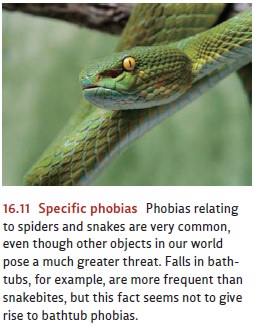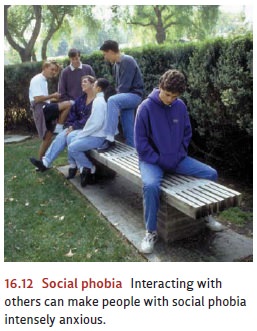Chapter: Psychology: Psychopathology
Anxiety Disorders: Phobias
Phobias
A
phobia is characterized by intense
and irrational fear coupled with great efforts to avoid the feared object or
situation (Figure 16.10). The word irrational
is important here. Someone living in the middle of a swamp and constantly
worried about snakes is not manifesting a phobia; her fear is perfectly
reasonable. But someone living in a San Francisco apartment and incapacitated
by the same fear probably does have a phobia. And it does not help that the
person with the phobia knows that the fear is groundless; for someone with a
phobia, this knowledge does not in any way diminish the fear.

SPECIFIC PHOB AS
There
are several types of phobias, including specific
phobias, that are directed at a par-ticular object, like snakes or blood
(Figure 16.11). During the nineteenth century, many of these irrational fears
were cataloged and assigned exotic-sounding Greek or Latin names. Examples are
fear of high places (acrophobia), enclosed places (claustropho-bia), crowds
(ochlophobia), germs (mysophobia), cats (ailurophobia), and even the number 13
(triskaidekaphobia)—the list is long. However, these phobias are not equally
common; some are quite frequent (fear of heights, fear of snakes); others are
extremely rare (fear of specific numbers). Overall, though, the lifetime
prevalence for any kind of specific phobia is estimated at 13% (Kessler et al.,
2005), and women are about twice as likely as men to have specific phobias
(Bourdon et al., 1988).

Some
of these phobias seem relatively harmless, but others can be life changing,
because the person suffering from a phobia almost always develops strategies
(sometimes elaborate ones) for avoiding the phobic object. Thus, people with
claustro-phobia may climb many flights of stairs rather than step into an
elevator. Likewise, an executive with a fear of heights may choose to quit his
job rather than accept a promo-tion that gives him an office with a glorious
view from a 20th-story window. These pho-bias will often expand in scope, so
that a fear of spiders, say, can grow to become a fear of insects—and a fear of
being outdoors where the spiders or insects might lurk, or a fear of anything
brushing across the person’s face, because it might be a spiderweb.
How
do these fears feel to the person experiencing the phobia? One person describes
the fear of flying this way:
I
used to start dreading a plane trip a month before I was due to leave. It was
an awful feeling when that airplane door closed and I felt trapped. My heart
would pound, and I would sweat bullets. When the airplane would start to
ascend, it just reinforced the feeling that I couldn’t get out. When I think
about flying, I picture myself losing control, freaking out, and climbing the
walls, but of course I never did that. I’m not afraid of crashing or hitting
turbulence. It’s just that feeling of being trapped. . . . These days I only go
places where I can drive or take a train. My friends always point out that I couldn’t
get off a train traveling at high speeds either, so why don’t trains bother me?
I just tell them it isn’t a rational fear.
Similar
accounts can be offered for most of the other specific phobias, but, even so,
one of the phobias is unique: the blood-injection-injury phobia. This phobia
often is experienced as a feeling of disgust
rather than fear, and is also
distinctive in how people react to the feared object. For most phobias, an
encounter with the phobic stimulus produces panic responses: quick pulse,
elevated blood pressure, sweating, and tremor. These are all emergency
reactions produced by the sympathetic branch of the auto-nomic nervous system.
For the blood-injection-injury phobia, the reaction is essentially the
opposite. The pulse slows, the blood pressure drops, the muscles go slack, and
the person can fall to the ground in a faint. In addition, the treatment for
blood-injection-injury phobia runs exactly opposite of that for other phobias.
For most phobias, the treatment involves teaching the phobic person to relax.
For the blood-injection-injury phobia, the sufferer must keep up her blood
pressure, and so must learn, on cue, to become tense (Hellstrom, Fellenius,
& Ost, 1996).
SOCIAL PHOBIA
Unlike
the object-specific fears seen in specific phobias, individuals with social
phobia (also referred to as social anxiety disorder) are intensely afraid of
being watched and judged by others (Figure 16.12). Typically, these concerns
center around negative evalu-ations (“He’ll think I’m an idiot”), but there is
increasing evidence that even positive evaluations can be threatening (Weeks,
Heimberg, Rodebaugh, & Norton, 2008). The lifetime prevalence for social
phobia is 13% (Kessler et al., 2005), and women and men are equally affected by
this disorder.

Social
phobia typically emerges in childhood or adolescence (Robins & Regier,
1991) and may be accompanied by other anxiety disorders or depression (Regier
et al., 1998). Sometimes a person’s fears are limited to one type of situation
(e.g., speaking in front of others, writing in front of others, or eating in
front of others). For others, many different situations trigger the anxiety; in
this case, social phobia is described as being “generalized.”
People
with social phobia will desperately try to avoid situations in which they must
expose themselves to public scrutiny. They will avoid public speaking or
performing because they think others will think they are stupid, they will not
eat in restaurants for fear that they will choke on their food, and they will
not go to parties or meetings because they may stutter and stammer when trying
to talk. As one person with social anxiety disorder put it, “In school I was
always afraid of being called on, even when I knew the answers. When I got a
job, I hated to meet with my boss. I couldn’t eat lunch with my co-workers. I
worried about being stared at or judged, and worried that I would make a fool
of myself. My heart would pound, and I would start to sweat when I thought
about meetings. The feelings got worse as the time of the event got closer.
Sometimes I couldn’t sleep or eat for days before a staff meeting”. When forced
into situations of this sort, they may try to “fortify” themselves with alcohol
or drugs, making substance abuse or dependence a real risk (Pollack, 2001).
Related Topics